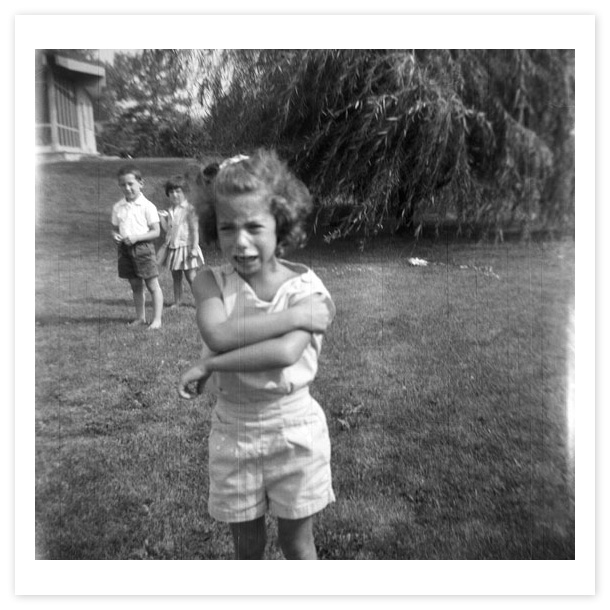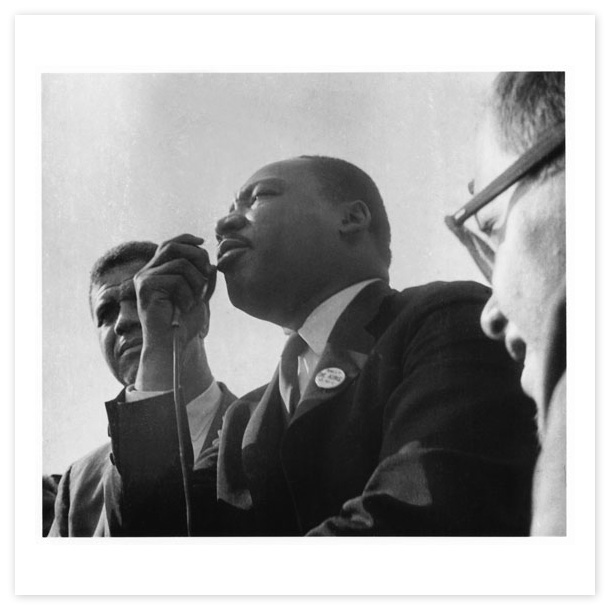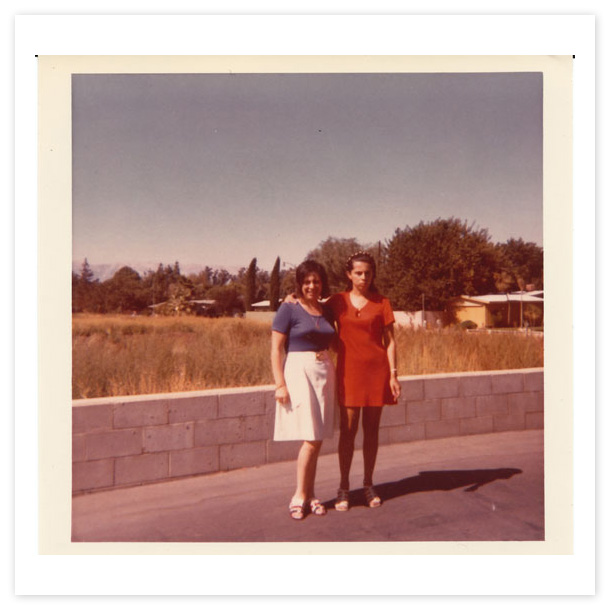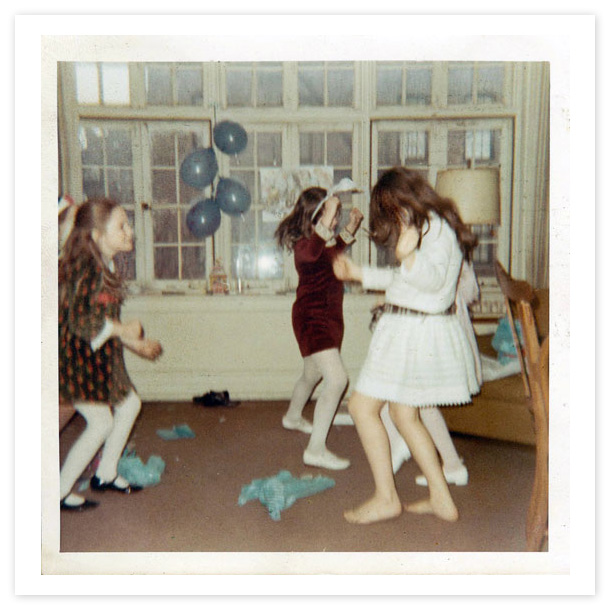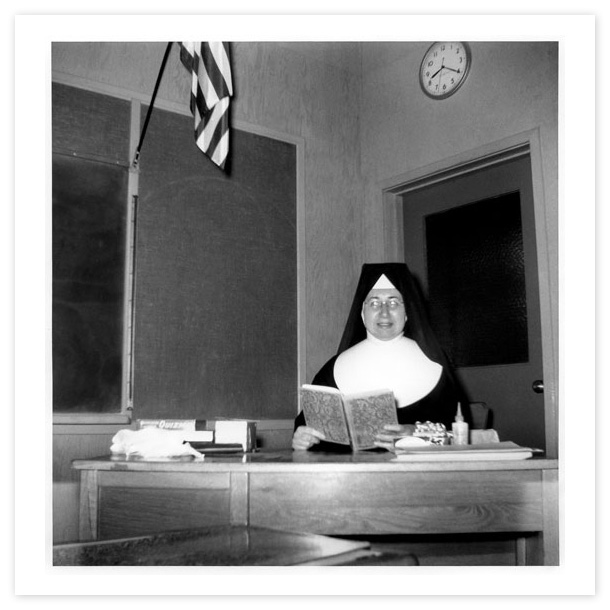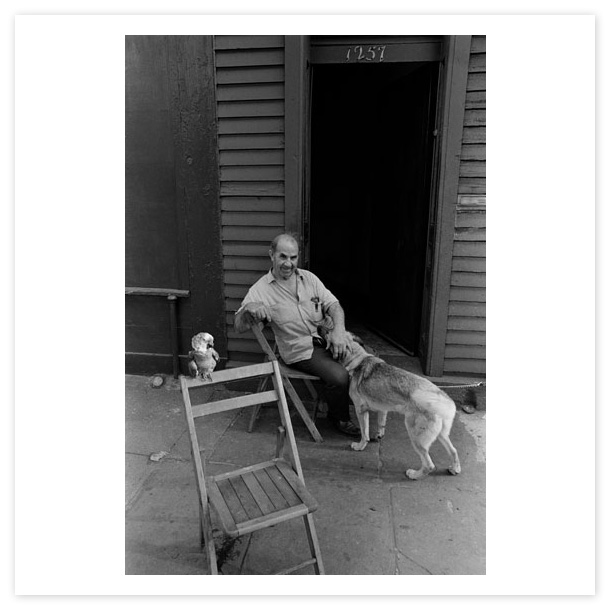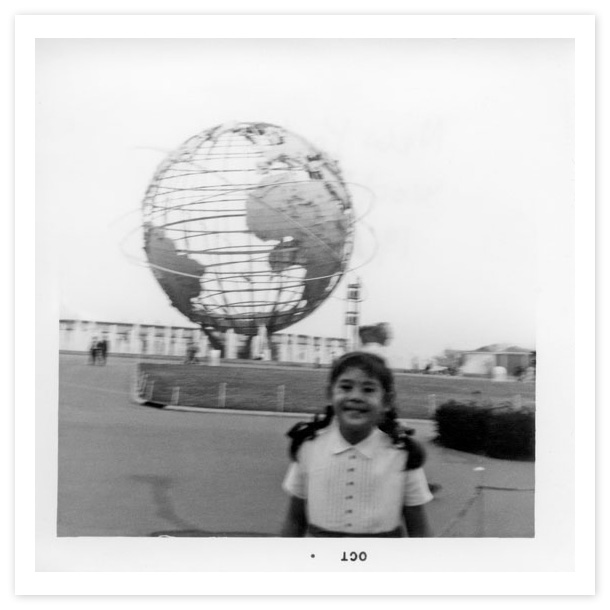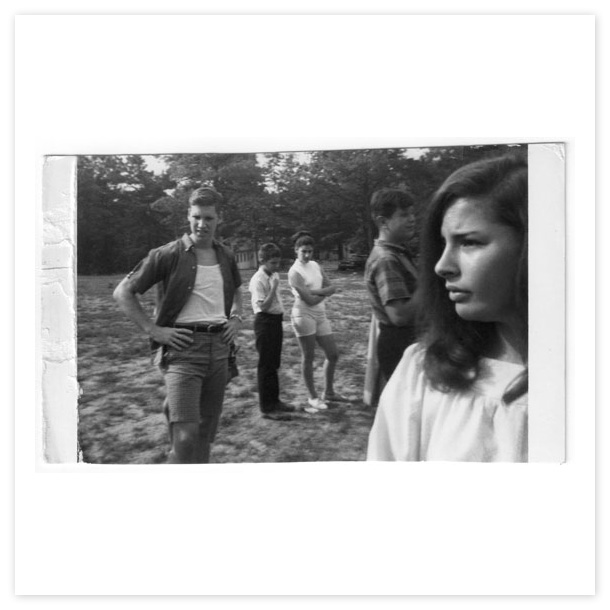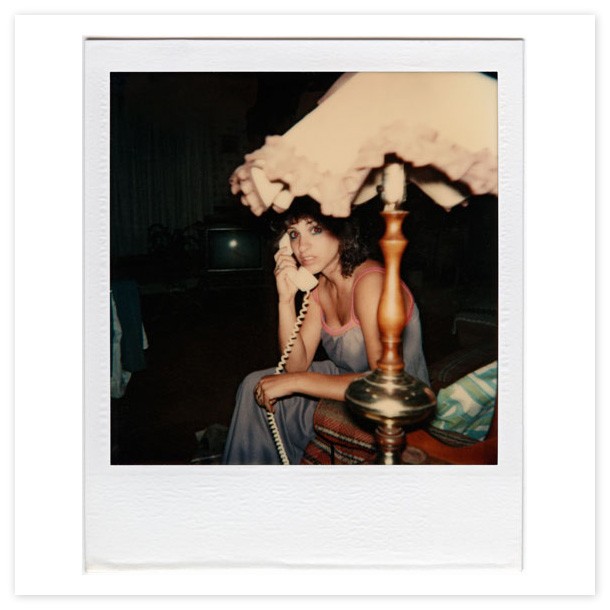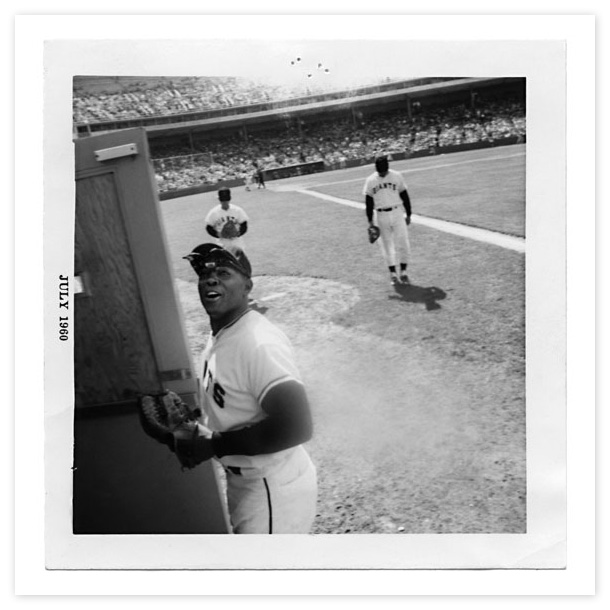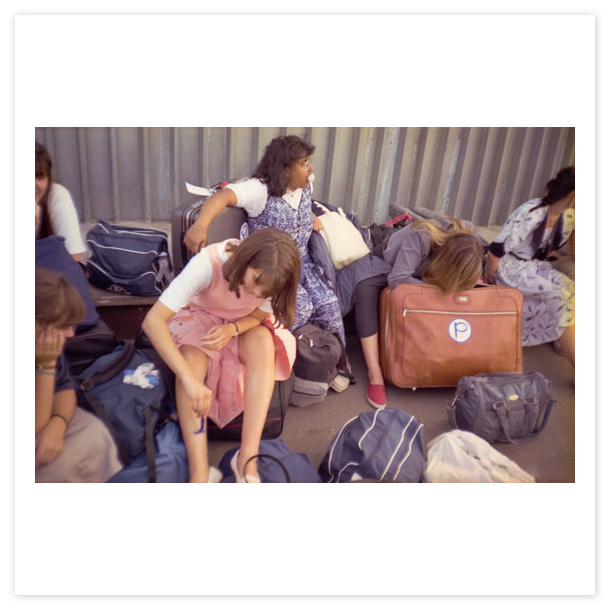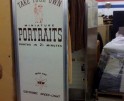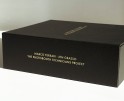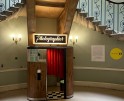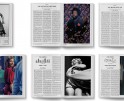Laura Moya and Laura Valenti: Early Works
Rich Frishman writes:
In 1956 my grandfather gave me my first camera. It was my fifth birthday, and life has never been the same. Immediately I set to photographing my world, especially my family. My sister Pammy had to endure me the most.
Although she may remember things a bit differently, I was not a bully. I was just a big brother. Yes, I did break her arm about three years after I took this particular picture, but I didn’t mean to. Really, I just wanted to watch “The Honeymooners,” not “Casper.”
Back to this picture. It was 1958, Eisenhower was in the White House, and we were playing with our neighbors Michael and Suzy in their backyard. I was photographing them, which was (and is) how I related to the world, and Mikey did something to my sister. You can tell just by looking at him. And my sister was a crybaby. I mean really, it was like her hobby.
Perhaps as a result of my always annoying my sister with my camera, she fell in love with photography, too. She is now a photography gallery director. Had I known how things would turn out, I would have treated her better.
Rich Frishman’s wonderful image and story are just one of many in the terrific Early Works Exhibition, curated by Laura Moya and Laura Valenti, the heart and soul of the Photolucida board. I remember seeing the Early Works call for entry and thinking, “I don’t have any work for this”, but after looking at the selected images, I thought of countless things I photographed growing up–summer camp, friends, my dog. Laura Moya and Laura Valenti didn’t expect such an incredible response to this project: The exhibition has traveled to five venues across the country and is now on display at the Photographic Resource Center in Boston. The Boston Globe recently gave the exhibition a great review and writer Mark Feeney contextualizes the work so succinctly: “None of the photographs are necessarily great. But precisely because the balance between external world and internal response to that world is much less disproportionate in photography than it is in literature, all are engaging — and sometimes well beyond that. The viewer can all but feel these budding photographers’ sense of discovery. There is enormous charm in being able to peek in on youthful wonder and excitement.” The exhibition will run through March 15th.
The exhibition includes images and narratives by: Corey Arnold, Roger Ballen, Douglas Beasley, Steven Beckly, Sheri Lynn Behr, Lori Bell, Jesse Burke, Richard S. Chow, Joseph Deiss, Maureen Drennan, Deena Feinberg, Gloria Baker Feinstein, Rich Frishman, Michael Jang, Zoltan Jokay, Ann Kendellen, Lewis Koch, Hannah Kozak, Varese Layzer, Phoebe Lickwar, Jim Lommasson, Anne Leighton Massoni, David Pace, Stephen Perloff, Jaime Permuth, Alexis Pike, Jordan Reznick, Trix Rosen, T. Scott, Jack Semura, Frederick Sharpe, Marsha Stewart, Stephanie Williamson, and Charlyn Zlotnik
The Curators Discuss the Exhibition
Thoughts from Laura Valenti:
A couple years ago, I posted a group of photographs I made when I was five years old on Facebook. I had begged my mother for her camera and hit the ground running when she finally gave in and let me use it. I actually compiled a whole album of my first photos, right after I made them, complete with messy image notes in crayon. It’s something I really treasure. Laura Moya saw the pictures on Facebook and commented that it would be a great idea for an exhibit. It turned out she had some of her first images, as well. So, we met over coffee and shared photos and stories about our childhoods.
We grew so enamored with the idea of an exhibition that we put out a call for entries and pitched the idea to the folks at Newspace Center for Photography here in Portland, Oregon. They liked the concept and offered us our first exhibition. RayKo Photo Center generously agreed to print the images for the show, and they hosted the second exhibition in San Francisco later that year. From there, Early Works traveled to the Center for Fine Art Photography in Fort Collins, the Sol Mednick Gallery at the University of the Arts in Philadelphia, and the Photographic Resource Center in Boston, where it is now showing. We really just expected to have one little exhibition, but the show has taken on a life of its own.
The public response has been incredibly gratifying. Actually, at a few of the openings we’ve heard that gallery-goers have started crying, because the images and stories have made them so nostalgic about their own childhoods. We feel a bit bad that our exhibition has made people cry! But, we’ve been incredibly moved by the images and stories, as well.
We can’t say enough about the artists in this exhibition. They’ve shared beautiful, tender, vulnerable moments with us and with viewers. Early Works is bursting at the seams with heart and soul, thanks to the incredible photographers who are a part of the project.
Thoughts from Laura Moya:
In 2013, my aunt, who I was close to in my childhood, died suddenly of cancer. Looking through my family photos, I came across an image I had taken of her with a Polaroid Camera when I was eight. The memory of my aunt at that time, along with the recollection of using a camera, came flooding back, clear as day. This led to talking to Laura Valenti about different childhood experiences using cameras, which sparked the larger idea of this project.
Getting it off the ground happened pretty quickly. Ann Jastrab at RayKo Photo Center was an early supporter of the idea, for which I am grateful. When we did the call for entries, we were curious as to how many photographers got bitten by the photography bug early on. We were also curious how the camera played a role in helping children navigate the ups and downs of what life throws at them. I am a sucker for a good autobiographical story, and these narratives did not disappoint.
Experiencing the support of the Early Works by the photo community at large has been very gratifying – from people spreading the word about the call for entries, to the photographers themselves, to feedback from people who have attended the exhibitions, to venues wanting to showing the work. We feel this project has truly resonated – the collective interest in the idea confirms for us that photography is an important language, a creative and necessary means of expression.
Many have remarked that the image/narrative concept of the project would translate well into book form, an idea that intrigues us!
A selection of the images follow. For a complete viewing, please visit the Early Work website.
Lewis Koch writes:
I made this photograph when I was 15 or 16 years old. My family and I were active members of the Long Island chapter of CORE (Congress of Racial Equality), and I had the great privilege of hearing Dr. King speak a few times in the mid-1960’s.
In the late 1970’s I discovered a roll of film in the basement of my parents’ house. For some reason, I never developed it. I remember having a miniature twin-lens reflex camera that used 127 roll film, by then already obsolete, so developing reels were difficult to find. Once I processed the film, I discovered this image. I still consider it to be one of the most significant images I’ve made over the course of fifty years of picture-making.
That day, Dr. King was speaking from the back of a pickup truck at a fair housing rally in West Hempstead, NY, and I had the advantage of being small enough to work my way to the front of the crowd to make this picture.
It’s hard to express just how moving it was to see the negative appear—somewhat diminished by time, but still there, with the ghosted figure of a childhood hero returning from beyond the pale, 15 years later.
Hannah Kozak writes:
I started using my father’s Brownie camera when I was ten years old. I loved making photos of my family and friends. I became intimate with photography from that point forward.
The year is 1972. I am twelve years old and my grandmother is dying of Leukemia in the West Hills Hospital. My mother is on the right wearing a favorite orange dress. Her older sister Esther is on the left. I made this photo of the two of them outside of the hospital. I love that my mother is showing her feelings while my aunt is striking a pose.
As my father and I drove away from the hospital for the last time, Cat Stevens’ “Morning Has Broken” played on the car radio. I knew I’d never see my grandmother again. Two years later, my mother wound up at UCLA Hospital intensive care. Her abusive, alcoholic husband had beaten her up again, leaving her on the floor of the bedroom in their home. Thirty-two years later, my mother is the longest-living resident in a home for the aged that she entered at the age of forty-two.
This photograph is the last one I made of my mother before she was in a wheelchair for life. My life would never be the same. Photography became a way of dealing with my feelings and emotions.
Stephanie Williamson writes:
I took this picture at my ninth birthday party in 1969 in our fourth-floor walkup apartment in Greenwich Village. I used my Kodak Instamatic 124 camera. We were dancing to The Beatles or The Stones. It was an Alice in Wonderland party and each girl had a party hat representing a character from the book. I was Alice, of course. My friend Nancy was the White Rabbit. She is the only one here who has not lost her headgear. My mother put “Drink Me” labels on our cups and “Eat Me” signs on toothpicks in each slice of cake. You can see the buildings across the courtyard out the window. In the summer we could sometimes hear whole conversations and a tinkling piano. A man with a clubfoot used to sit in his window and read the newspaper, with his bulbous shoe propped on the sill.
This picture makes me think of the juxtaposition of innocence and sophistication we experienced growing up in that time and place. Just a year later, the Weather Underground blew up a building four blocks away. A boy at school said they found a finger on the street after the bombing. This was during Vietnam, and peace rallies and protests were a regular things. Yet, we still had birthday parties and dressed in velvet dresses. In a year or two these would become slumber parties where we had séances and tried to contact people like Jimi Hendrix and Bobby Kennedy with a Ouija Board.
David Pace writes:
I was raised by nuns. This is Sister Mary St. John, sitting behind her desk in the second grade. She was a tough cookie. All the nuns were tough at St. Martin’s Grammar School in Sunnyvale. Sister St. John wasn’t mean like some of the others, just stern. Discipline always came first. How else could she survive in a classroom packed with more than fifty unruly kids? She was a wily, battle-hardened veteran with eyes in the back of her head. I was convinced they were concealed behind that long black veil. What else was hidden under there? Did she have hair? What kind of ears did she have that allowed her to hear the softest whispering, way back in the last row? She taught me to be observant and wary—good training for a photographer.
I took this picture one morning before class with my Kodak Brownie Hawkeye, a black plastic box camera that I received for my eighth birthday. It shot 620 film and produced a pretty good 2 1/4 inch negative. I often took my Hawkeye to school and photographed my classmates and teachers. Even as a child I realized that the person who holds the camera is in control. It gave me a feeling of power. I could look Sister St. John straight in the eye through my viewfinder and think, “I’m in charge here.” Look this way. Smile. Hold it. Good!
Roger Ballen writes:
In the late 1960’s I began to feel passionate about photography. In the summer of 1969, I lived in Brooklyn, New York and during my daily excursions I would look at the scenes on the sidewalks for interesting photographs. I shot this one of the man, dog, and bird in 1969 during the month that a man landed on the moon for the first time.
This was the first photograph that I shot of a bird. It has become an important milestone in my career, as at the end of the year Thames and Hudson will be publishing a book of bird images in a strange surrealistic place that I have worked in over the past six years.
Douglas Beasley writes:
This is a picture of my sister Linda at the 1964 World’s Fair in New York City. It was made on my Kodak Instamatic, the first camera I ever owned. Linda died a couple years ago after a long battle with alcoholism. It really wasn’t much of a battle as the alcohol always held the upper hand. It had been that way since she was a teenager. This image represents a time when our family could still pretend we were normal and that there was still a possibility that Linda could grow up and live happily ever after.
I miss her.
Sheri Lynn Behr writes:
I was 14 when I went to sleep-away camp for the first time. I don’t know what made me decide to bring a camera with me, except that photography was important in my family. When I was younger, we always had photos taken on family vacations. The camera I used to take this image was a Kodak Hawkeye Flashfun, and amazingly, I still have it.
The photos I made that summer are the first pictures I took myself—pictures of the girls in my bunk and the boys we liked. Most of them were straight on, subject in the middle, smiling and slightly stiff. Typical snapshots. I was just collecting images of the summer friends I might not get to see all year.
This picture was different from the others. Danny and Angel. I’m pretty sure they were a couple. I didn’t get to see the photograph until I was home from camp, but I remember that I found it intriguing. The next summer I took a few more unposed pictures, and I started to experiment with the camera just a little bit more.
When I found this image, I realized that I cropped my photographs from that summer. Though back then, it was with a pair of scissors.
Jesse Burke writes:
This is an image of my mom on the phone at my grandparent’s house. We were living there after moving from Arizona where my parents had recently split up. She is probably about 23 or 24 in this picture, which makes me about six or seven and my sister three. She looks so young, so beautiful. Her blank expression makes me think about how crazy her life was at this point: young, single/recently divorced, mother of two, disco diva, hardcore Italian family girl. It must have been so hard—I can’t imagine trying to juggle all that responsibility at that age.
We would stay at my grandparents’ house all the time; it was a traditional and stable place. They served as my part-time caretakers. My mother would go out with her girlfriends to discos and my grandparents would watch me and my sister. Mom had these electric-blue, skin-tight stretch pants. Her friends were all so young and pretty, but they were wild as well. In this picture she has on some pretty serious teal eye shadow. You can see the checkered, scratchy, polyester couch there, too. My skin crawls just thinking of it.
This image brings back so many memories for me, good and bad. It was a chaotic time in all our lives, so this image allows me to remember the quieter times. She looks so peaceful, caught in a moment. I want to know who is on the other line. It looks like she’s getting ready to head out and become the disco queen.
Michael Jang writes:
“They throw the ball, I hit it.
They hit the ball, I catch it.”
– Willie Mays
It was 1960, and the San Francisco Giants were playing their first season at Candlestick Park. I remember getting to the park early to watch batting practice and run around some before the ushers made me sit in my assigned seat for the game. The players entered and exited the field through a door along the right field line.
After borrowing my dad’s camera (a Bell & Howell Electric Eye 127), I waited like a young paparazzi in what I thought would be the best place to get a shot of the Giant’s center fielder. I remember that I preferred taking pictures to getting autographs.
And yes, that is a finger smudge on the lens.
Anne Leighton Massoni writes:
My first camera was a gift from my grandmother for Christmas. It was a lightweight, plastic-bodied point-and-shoot. I don’t remember the brand and model. My father was the family photographer; while I may have handled a camera before receiving this gift, I have no memories of framing and making images until this “first” camera.
During the summer of 1989, I traveled to the Soviet Union with People to People as a Student Ambassador. The exploration I experienced by way of the lens was a revelation. I had found a way to engage with people whose language I did not speak, whether it was with shared smiles, gestures, or broken Russian. I had found the way to make little slices of time into images, and a way to collect moments that would be catalysts for narratives for decades to come.
I told myself when I made this image that I would never forget the moment. We were on the airport tarmac, waiting for a plane. It was warm; we’d been traveling for about two weeks. It made me smile that a girl pulled out shaving cream and a razor and began shaving her legs, it made me smile that she was the only one in pink in a sea of blue.
When I left the USSR, I felt I’d learned so many things. I came home wanting to make more images, to study photography, and to use the images I made to share and tell stories.
Posts on Lenscratch may not be reproduced without the permission of the Lenscratch staff and the photographer.
Recommended
-
Spotlight on the Photographic Arts Council Los AngelesNovember 23rd, 2025
-
100 Years of the Photobooth: Celebrating Vintage Analog PhotoboothsNovember 12th, 2025
-
100 Years of the Photobooth: The Photobooth Technicians ProjectNovember 11th, 2025
-
100 Years of the Photobooth: Rafael Hortala-Vallve: AUTOFOTONovember 10th, 2025
-
BEYOND THE PHOTOGRAPH: Q&A WITH PHOTO EDITOR JESSIE WENDER, THE NEW YORK TIMESAugust 22nd, 2025

